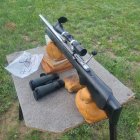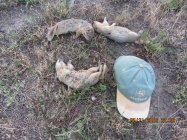It seems that each time there is a post from a new shooter that the suggestions are all over the place as far as calibers, scopes, and other equipment that may be needed.
PD shooting is like most other things in life - it is easy to over complicate it.
I have been shooting PD's and ground squirrels for decades and would like to share some equipment suggestions to the new PD shooter. I am fortunate in that I live in a target rich enviroment, by mid-summer I have usually shot 3000 - 4000 rounds at ground squirrels and PD's.
A lot of new shooters may only go one time because of the expense, time constraints, family obligations, etc. No matter how enjoyable it may be it is not inexpensive.
Before you lay out a lot of money on equipment consider the KISS method - "learn to walk before you try to run".
Don't spend a small fortune buying stuff that is not necessary, after the first trip then you will have a lot better idea of what does and doesn't work for you.
Firearms - an accurate bolt action, a bolt action helps you pace yourself when shooting. You will find that you will take time to make the shot rather than trying quick follow-up shots that often happens with semi-autos.
Cartridge - 223 Rem. with 40 or 50 gr bullets.
Why? Multiple reasons.
Most PD shooting takes place within 300 yards, after that the hit ratio drops quickly and most shooters would agree that hitting is more fun than missing. There is nothing wrong with trying some 400 - 600 yd shots but you will likely soon go back to the shorter ranges for the higher hit probability.
Another reason for the 223 is that if you aren't a handloader there is a good availability of off the shelf ammo at reasonable prices. If you are a handloader the 22 caliber gives a good selection of components from various manufacturers and often at better prices, with brass being reasonably priced and free if you use range pick ups.
Recoil - if you are lucky enough to get into a good PD field 300 or more shots per day are doable and shooting heavier bullets creates more recoil and it will begin to wear on you. Recoil is cumulative. Even a 223 shooting 50 gr bullets can start to wear on you by the end of the day - remember this is supposed to be fun, not an endurance contest where you begin to dread pulling the trigger.
Multiple Firearms - I have mixed emotions about suggesting multiple firearms because the cost another firearm and scope incurs.
If you do take two firearms I suggest that both firearms be for the same cartridge with the same load, by doing that you aren't as likely have to be jumbling drop and drift differences around in your though process. It is amazing at how quickly the drop and drift become intuitive when using the same cartridge and load over and over.
While it is nice to have a couple of firearms in case the shooting gets fast, you can get by with just one by laying a wet rag on the barrel to keep it cooled down.
Scope - Any good variable. There is no point in spending the money for a high magnification scope because of heat and barrel heat mirage it becomes difficult to use much above 15 power anyway. Just be sure that the glass is good enough that it doesn't tire your eye out and cause eyestrain.
A scope with a "fancy" reticle is not necessary - sight in at one-inch high at 100 yards and hold the crosshairs at the top of the head at 300 yards. Basically you can hold on fur from 100 to 300 yards.
Rangefinder - They are handy to have but not absolutely necessary, although they will help you to learn to judge distances better - it is surprising how many of those 400 - 500 yard guesstimates are actually inside of 300 yards.
Binocular - Again they don't have to be top-end, a good pair of 10X that don't give eyestrain will work just fine.
Shooting Table - Nice to have but unless you have a big field with lots of targets setting up and taking down a shooting table becomes a pain in the butt. I generally just use one of the sand filled canvas bags across the hood of my truck because it is faster and makes me more mobile.
Spotting PD's - When I am shooting and spotting with a friend we will try to find some prominent feature in the field, such as a rock, an oddly shaped bush, anything like that so it is easily identifiable and use that as the center of the clock when directing shots for each other. Doing this saves a lot of time trying to locate targets. and adds more fun since the spotter and shooter get to see the results.
Example - "from the rock there is a PD at 2 o'clock about 50 yards out".
PD shooting is like most other things in life - it is easy to over complicate it.
I have been shooting PD's and ground squirrels for decades and would like to share some equipment suggestions to the new PD shooter. I am fortunate in that I live in a target rich enviroment, by mid-summer I have usually shot 3000 - 4000 rounds at ground squirrels and PD's.
A lot of new shooters may only go one time because of the expense, time constraints, family obligations, etc. No matter how enjoyable it may be it is not inexpensive.
Before you lay out a lot of money on equipment consider the KISS method - "learn to walk before you try to run".
Don't spend a small fortune buying stuff that is not necessary, after the first trip then you will have a lot better idea of what does and doesn't work for you.
Firearms - an accurate bolt action, a bolt action helps you pace yourself when shooting. You will find that you will take time to make the shot rather than trying quick follow-up shots that often happens with semi-autos.
Cartridge - 223 Rem. with 40 or 50 gr bullets.
Why? Multiple reasons.
Most PD shooting takes place within 300 yards, after that the hit ratio drops quickly and most shooters would agree that hitting is more fun than missing. There is nothing wrong with trying some 400 - 600 yd shots but you will likely soon go back to the shorter ranges for the higher hit probability.
Another reason for the 223 is that if you aren't a handloader there is a good availability of off the shelf ammo at reasonable prices. If you are a handloader the 22 caliber gives a good selection of components from various manufacturers and often at better prices, with brass being reasonably priced and free if you use range pick ups.
Recoil - if you are lucky enough to get into a good PD field 300 or more shots per day are doable and shooting heavier bullets creates more recoil and it will begin to wear on you. Recoil is cumulative. Even a 223 shooting 50 gr bullets can start to wear on you by the end of the day - remember this is supposed to be fun, not an endurance contest where you begin to dread pulling the trigger.
Multiple Firearms - I have mixed emotions about suggesting multiple firearms because the cost another firearm and scope incurs.
If you do take two firearms I suggest that both firearms be for the same cartridge with the same load, by doing that you aren't as likely have to be jumbling drop and drift differences around in your though process. It is amazing at how quickly the drop and drift become intuitive when using the same cartridge and load over and over.
While it is nice to have a couple of firearms in case the shooting gets fast, you can get by with just one by laying a wet rag on the barrel to keep it cooled down.
Scope - Any good variable. There is no point in spending the money for a high magnification scope because of heat and barrel heat mirage it becomes difficult to use much above 15 power anyway. Just be sure that the glass is good enough that it doesn't tire your eye out and cause eyestrain.
A scope with a "fancy" reticle is not necessary - sight in at one-inch high at 100 yards and hold the crosshairs at the top of the head at 300 yards. Basically you can hold on fur from 100 to 300 yards.
Rangefinder - They are handy to have but not absolutely necessary, although they will help you to learn to judge distances better - it is surprising how many of those 400 - 500 yard guesstimates are actually inside of 300 yards.
Binocular - Again they don't have to be top-end, a good pair of 10X that don't give eyestrain will work just fine.
Shooting Table - Nice to have but unless you have a big field with lots of targets setting up and taking down a shooting table becomes a pain in the butt. I generally just use one of the sand filled canvas bags across the hood of my truck because it is faster and makes me more mobile.
Spotting PD's - When I am shooting and spotting with a friend we will try to find some prominent feature in the field, such as a rock, an oddly shaped bush, anything like that so it is easily identifiable and use that as the center of the clock when directing shots for each other. Doing this saves a lot of time trying to locate targets. and adds more fun since the spotter and shooter get to see the results.
Example - "from the rock there is a PD at 2 o'clock about 50 yards out".














